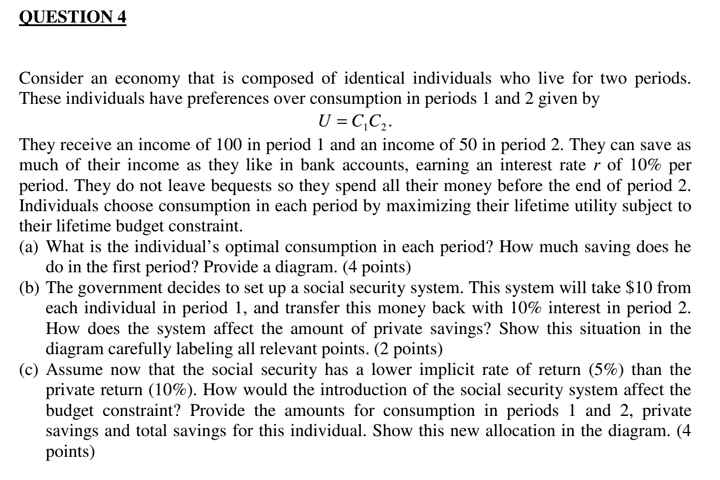Question
QUESTION 4 Consider an economy that is composed of identical individuals who live for two periods. These individuals have preferences over consumption in periods 1
QUESTION 4
Consider an economy that is composed of identical individuals who live for two periods.
These individuals have preferences over consumption in periods 1 and 2 given by
U = C C21 .
They receive an income of 100 in period 1 and an income of 50 in period 2. They can save as
much of their income as they like in bank accounts, earning an interest rate r of 10% per
period. They do not leave bequests so they spend all their money before the end of period 2.
Individuals choose consumption in each period by maximizing their lifetime utility subject to
their lifetime budget constraint.
(a) What is the individual's optimal consumption in each period? How much saving does he
do in the first period? Provide a diagram. (4 points)
(b) The government decides to set up a social security system. This system will take $10 from
each individual in period 1, and transfer this money back with 10% interest in period 2.
How does the system affect the amount of private savings? Show this situation in the
diagram carefully labeling all relevant points. (2 points)
(c) Assume now that the social security has a lower implicit rate of return (5%) than the
private return (10%). How would the introduction of the social security system affect the
budget constraint? Provide the amounts for consumption in periods 1 and 2, private
savings and total savings for this individual. Show this new allocation in the diagram. (4
points)

Step by Step Solution
There are 3 Steps involved in it
Step: 1

Get Instant Access to Expert-Tailored Solutions
See step-by-step solutions with expert insights and AI powered tools for academic success
Step: 2

Step: 3

Ace Your Homework with AI
Get the answers you need in no time with our AI-driven, step-by-step assistance
Get Started


